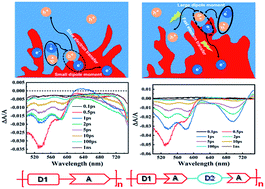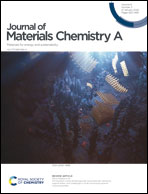Fluorinated D1(0.5)–A–D2(0.5)–A model terpolymer: ultrafast charge separation kinetics and electron transfer at the fluorinated D/A interface for power conversion†
Abstract
A model fluorinated semiconductivity terpolymer, PBTA-PS-F (D1–A–D2–A), was synthesized and used in polymer solar cells (PSCs). This terpolymer possessed optimal energy levels (HOMO and LUMO, −5.48/−3.53 eV) and a complementary absorption region with small molecule acceptor ITIC. Two-dimensional grazing incidence X-ray (2D-GIXD) studies indicated that PBTA-PS-F exhibits strong lamellar stacking and preferable face-on orientation in the pristine film and the film blended with ITIC. A large ground to excited state dipole moment Δμge of 1.84 D was calculated for PBTA-PS-F, which was larger than that of its counterpart copolymer PBTA-PS (0.27 D). Furthermore, ultrafast electron transfer at the fluorinated terpolymer D/A interface was found from the ground state bleach signature (GSB) and excited state absorption signature (ESA) signals. Therefore, a high power conversion efficiency of 13.48% was achieved for the optimized PBTA-PS-F:ITIC device. As a result, employing structurally similar donor moieties as modulators to construct D1–A–D2–A model terpolymers can be used to improve the performance of polymer solar cells.



 Please wait while we load your content...
Please wait while we load your content...